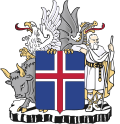Icesave bill 3
The background for the Icesave bills, was that the privately owned Icelandic bank Landsbanki was declared bankrupt on 7 October 2008. One day earlier the Icelandic state had passed an emergency law to guarantee for a full coverage of all lost deposit amounts for domestic Icelandic customers in any bankrupt Icelandic bank, while insisting however not to guarantee anything towards the foreign customers. This caused a split of Landsbanki into two parts, a domestic version (Nýi Landsbanki) – owned and fully guaranteed for by the Icelandic state – to be continued only with domestic customers and assets, and a foreign version (previously named Icesave) being placed in a receivership for liquidation. According to the Icelandic law about minimum deposit guarantees, the Icelandic Depositors' and Investors' Guarantee Fund (Tryggingarsjóður) was required to repay lost deposit amounts to customers in bankrupt financial institutions up till €20,887 per account holder.
As the bankruptcy of Landsbanki was one of 3 big systemically important financial institutions going bankrupt within a few days in Iceland, the Tryggingarsjóður however had already been drained from capital reserves, and had no money left to repay the legally required €4.0bn of minimum deposit guarantees to the 343,306 foreign retail customers from United Kingdom and Netherlands, who had lost all their €6.7bn of deposits in the Icesave branch of Landsbanki. Because nothing was expected immediately to be repaid by any Icelandic institutions/authorities, both the Dutch and British state decided to step in and cover all these account losses in full; while however at the same time demanding the Icelandic state should sign a loan guarantee agreement concerning repayment of the €4.0bn of Icelandic minimum deposit guarantees plus accrued interests. Subsequently, the terms for these loan guarantee agreements were negotiated between the states in the so-called Icesave bills, where Iceland to meet its obligations was offered a £2.35bn (€2.7bn) loan by UK and a €1.3bn loan by the Netherlands. Repayment of the €4.0bn of minimum deposit guarantees, was supposed to happen partly/entirely through the liquidation of remaining positive assets by the Landsbanki receivership in 2009–2015, with the Icelandic state only to overtake/guarantee for the potential remaining repayments in 2016.
After the electorates rejection of Icesave bill 2 in March 2010, some renewed negotiations immediately started about the adjustment of the terms for the loan guarantee repayment agreements, which was considered to be the root cause why the Icelandic people had rejected it. The negotiations resulted in December 2010 in a new adjusted version of the repayment agreement named Icesave bill 3, with better terms for Iceland. The improved terms included the removal of a previous creditor priority issue, and the introduction of a lower 3.2% interest rate in combination with interest moratorium for the first year until 1 October 2009; and if needed when the Icelandic state overtake repayment liabilities from the receivership in 2016, then also a possible extension of the "repayment window" up till 30 years.
Icelandic voters were asked to vote yes/no for Icesave bill 3. Ahead of the vote, the Landsbanki receivership (LBI) published a quarterly financial status, that estimated its total recovery of assets would equal roughly 96% (ISK 1263bn/1319bn) of all priority claims towards the receivership, which implied a full repayment of all minimum deposit guarantees already by the end of 2013, due to their first priority status within the "priority claims". [6] Assuming this estimate was correct, then the Icelandic state with Icesave bill 3 would only be liable in 2016 to conduct repayments to the British and Dutch states, for the accrued 3.2% interests related to the delayed repayment of minimum deposit guarantees in 2009–13. The Icelandic government also noted in the bill, that given these new more favorable terms, the expected total liabilities for the Icelandic state would only amount to ISK 47bn (€0.24bn) in 2016. [7]
